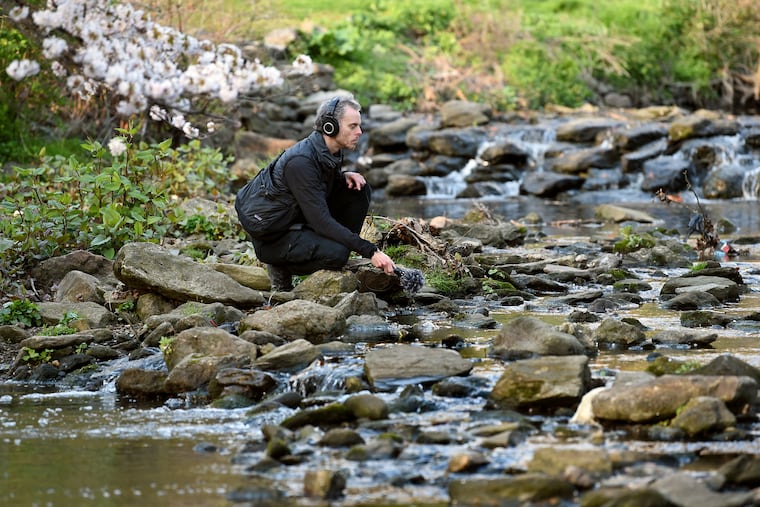This Philly musician imagines what extinct animals sounded like. His recordings may be the Zen-out tracks you need now.
Michael Reiley, also known as Mikronesia, engineers the sounds of today's animals and their habitats to construct soundscapes from the land before recordings.

A visit to any natural history museum (or, in these quarantined times, an afternoon of Google searching) can show you what prehistoric animals looked like, whether it’s through a reconstructed dinosaur skeleton or an insect preserved in amber. What the fossil record has not preserved is the sound of creatures that went extinct before recording devices came along.
With his new project, Echozoo, Philadelphia composer and sound artist Mikronesia, a.k.a. Michael Reiley, has created a sonic link to the distant past by recording — and then manipulating — the sounds of modern animals and their environments. He has recorded animals as close to home as the Wissahickon trails near his Germantown apartment and as far afield as Brazil, Iceland, Germany, Mexico, Costa Rica, Thailand, and India.
At his Echozoo website, echozoo.org, which launched in February after four years of development, visitors can hear the resonant grunt of the great auk, a penguin-like bird that foraged along the coastlines of the north Atlantic until the mid-1800s. Recordings of arctic terns and pigeons are layered with other sounds to build the fanciful recreation.
Here, too, is the booming voice of the elk moose (Cervalces scotti), a large antlered creature that lived alongside woolly mammoths and sabertooth cats in the late Pleistocene epoch. Its imagined soundscape combines elk sounds captured by Reiley in Washington state, ambient forest sounds from Washington and Oregon, and more.
Echozoo’s chirp of the Rocky Mountain locust, which swarmed the western U.S. and Canada until the end of the 19th century, has been recreated from modern-day crickets and black locusts recorded in Philly, Montana, and Ottawa.
While Reiley conducted research on the extinct animals and tried to align his soundscapes with their closest living relatives, he is quick to point out that Echozoo is not intended to be a scientifically accurate representation. “I never wanted this to be a science project,” he explained.
“It’s meant to be an artistic interpretation of what these creatures could have sounded like, and imagining what their sound world was like from their own perspectives, as opposed to something a biologist or zoologist would do, which is interesting and important work.
“The way I describe Echozoo is like a painting of a dodo bird,” he said. "It might not be 100 percent biologically accurate, but it’s an artist’s rendition.”
Inspired by ‘deep listening’
Echozoo is an outgrowth of several fascinations that have long driven Reiley’s work as Mikronesia.
Nearly a decade ago at West Philly’s Rotunda, he premiered the opera Pangaea: When the Continents Were One, which envisioned the folk music of ancient humans living on the supercontinent. In recent years his sound work has been closely intertwined with his longtime practice of Buddhist meditation.
Much of that work has been profoundly influenced by Reiley’s studies with the late composer Pauline Oliveros, a pioneer in the practice of “deep listening,” which combines aspects of composition and meditation.
“Pauline was revolutionary because she was interested in the way that soundscapes emotionally resonate within us and how our own listening consciousness colors what we’re listening to,” Reiley said.
“In the sonic art world, there’s a bit of divide between people who approach it more like a documentary filmmaker and those who treat field recordings as material. I’m in the latter camp,” he said. "I like to get into the narrative of what it’s like to listen to these sounds, the interior world of what listening is.”
Nature sounds to Zen-out to
Recognizing the way that these experiences might be helpful to those feeling the stress of social distancing and isolation, Reiley has also launched the YouTube channel Meditative Soundscapes, which offers longform ambient recordings accompanied by serene, mesmerizing visuals.
Current offerings include the hour-long Mystical Forest Soundwalk, featuring sounds captured during a walk through Fairmount Park coupled with peaceful electronic drones, and the hopeful, 7 1/2 minute Global Peace Sonic Meditation.
On Saturday, Reiley livestreamed a five-hour concert of “sleep music,” a calming soundscape meant to accompany slumber that was itself a further exploration of the idea behind his eight-hour 2014 recording Quiescent.
Not that all of Reiley’s influences are that esoteric. The process he explored for Echozoo was also sparked in part by the work of Ben Burtt, the sound designer for Star Wars and other movies, who constructed the sounds of alien creatures — and even spaceships and weaponry — by combining real animal noises with other elements.
Reiley’s approximation of the great auk, for example, is built upon a recording of a flock of Arctic terns that he captured feeding from fishing boats off the northern coast of Iceland, augmented by pigeons, ocean ambience, and synthesizer-generated sounds, all processed with a heavy reverb.
Beyond the purely imaginative aspects of the project, Reiley hopes that Echozoo will also give listeners pause to reflect on the animals that have been lost forever, not only in the prehistoric past but in recent years, as we find ourselves in the midst of what some scientists consider a sixth mass extinction.
“I hope that people who spend some time listening to these sounds will notice the natural soundscapes that we have now and develop a stronger connection to the natural world,” he said.
“I wanted to undo the notion of humans as separate from the ecosystem. We’re all sharing a similar conscious experience of existence, so hopefully this can shift the human-centric view.”